He is, by far, one of the greatest and most influential artists in history ever known. Michelangelo di Lodovico Buonarroti was the best-known Italian artist of his time. Michelangelo’s works were breathtaking, he was out of traditional poetic skills, an expert draftsman, and an incredibly skilled painter whose impact on the creative world knows no time boundaries.
He has a long history of rivalry with Leonardo da Vinci which is well documented. He is known to have stormed out of the Sistine Chapel in anger, but despite some of his somewhat bad reputation, his artwork is so good, that nothing could hold him down. To his contemporaries, he was known as II Divino, translated as the divine one. This was so because they deemed his handyworks unmatched among any merely mortal human.
Join me in this artistic journey today, give your eyes some of the rarest sights the world has ever known, and get your brains challenged as we dive deep into the roots of creativity, to remember this great one through seven of the topmost incredible creative Michelangelo’s works. So, let’s get started, shall we?
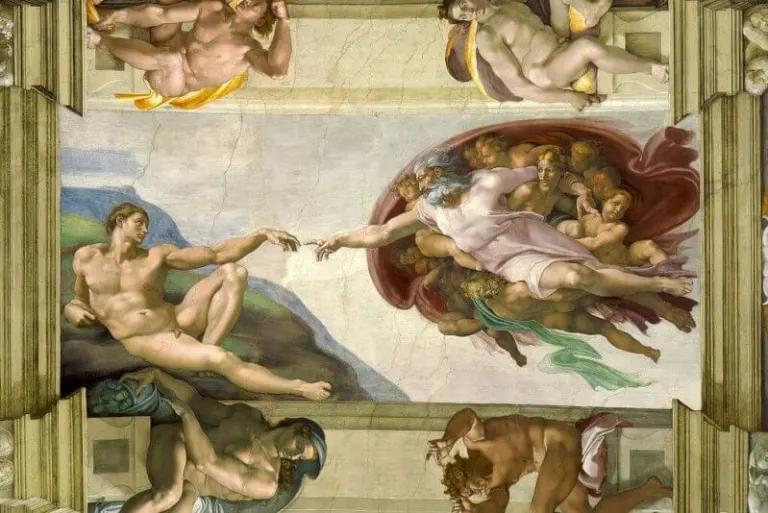
1 – The Sistine Chapel: the most famous of Michelangelo’s works
When you think of Michelangelo, one of the first things that ring in your mind is Michelangelo’s incredible artwork that now remains painted on the Sistine Chapel ceiling in Vatican City. He was commissioned to do this work by Pope Julus the Second.
Michelangelo was not particularly interested in taking up this job because he was, after all, not a painter but a sculptor. He came up with what today remains one of the most sacred pieces of art in western history. It attracts an average of five million people annually who flock to the Sistine Chapel to admire his handy work.

It is a tale of the creation story. It shows God extending His finger toward a newly created man, Adam, about to shower him with life. To other viewers, the red color at the back of the drawing of God’s shape resembles the human brain, and to them, this means that God is about to give Adam the gift of life and infuse him with consciousness.
Eve watches this event from the other side of God’s arm. In the same red cloud surrounding God are angels and cherubim. This is a rare tale of the creation story. Very few artists in all history have been able to bring out the Genesis creation narrative as dramatically as Michelangelo does in this show-stealing painting.
What makes this painting stand out from all others is that, unlike every other artist’s depiction of God as supreme and outrightly removed from any connection with man, Michelangelo brings out a whole different viewpoint.
He paints God to be having an intimate relationship with man, a creation of his image. Even in today’s contemporary society, this painting has been monotonously used to tell the entire story of Genesis. It has several times been cited and even borrowed and expanded on in other arts for its religious meaning.
2 – David: the most iconic of Michelangelo’s works
This is possibly the world’s most famous sculpture that came at the peak of Michelangelo’s career. This sculpture was created when Michelangelo was 26 years old, and it took him three years to bring it to completion. There have existed other statues of the biblical hero, David. However, these sculptures paint David as a victorious hero from his battles.
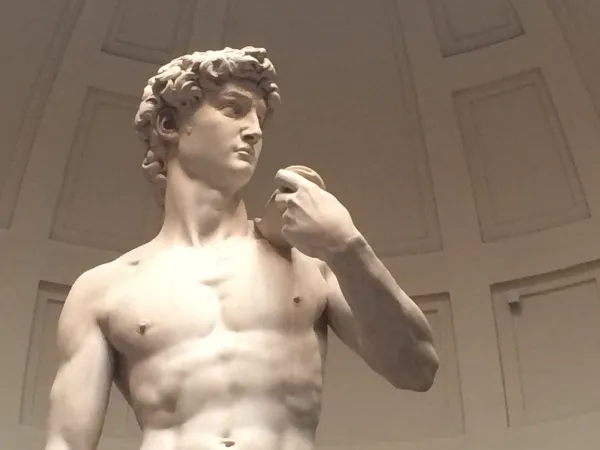
What makes this piece of Michelangelo's art stand out is that David is brought out in a tense and alert manner before his famous Goliath battle. While others have painted David as a little man, Michelangelo chooses to portray him as a muscular man, well prepared for war and confident. The 14-foot sculpture was primarily positioned in Florence at the Pizza Della Signoria in 1504. It was then moved in 1873 to Galleria dell ‘Accademia, where it remains to this day.
The sculptor has captured the attention and interests of renowned women like queen Victoria. During one of these visits, a detachable fig leaf from plaster was strategically added at the private parts’ top. Michelangelo picked up this marble project from another sculptor who had given up on it to take upon another because the marble’s structure was compromised.
This, however, did not stop him as he had to find a way to make it bring out the best of what he had in mind, a piece of art that was controversial and at the same time the same thing that elevated him to the top.
Donatello had revoked Michelangelo’s nudity and had come up with his sculpture. However, Michelangelo’s work version remains the most iconic and continues to attract attention to this day.
Some traveling exhibits of the statue have portrayed an accurate resemblance to the original sculpture and are in favor of the many who cannot travel to Italy to view this masterpiece.
On a different occasion, however, when the municipality of Jerusalem was marking the 3000th anniversary of King David had conquered the city, religious groups in Jerusalem urged for the decline of David’s sculptor, claiming that it is pornographic due to its being nude.
3 – Bacchus: the most controversial of Michelangelo’s works
This was Michelangelo’s first-ever forays into large-scale sculpturing. This also marks one of the few works he has done that has no Christian background. Completed in 1497, the statue portrays a Roman god, the God of wine, drunk, and lazy.
The God is holding a goblet in one hand, posturing to bring it to the mouth to have a drink, and on his head, wears an intertwined ivy.
He carries a lion’s skin, the symbol of death borrowed from Hercules’ myth, in his other hand. At the back of his left leg is his demigod companion, which signifies Bacchu’s cult, which often symbolizes a lusty, drunken woodland being.
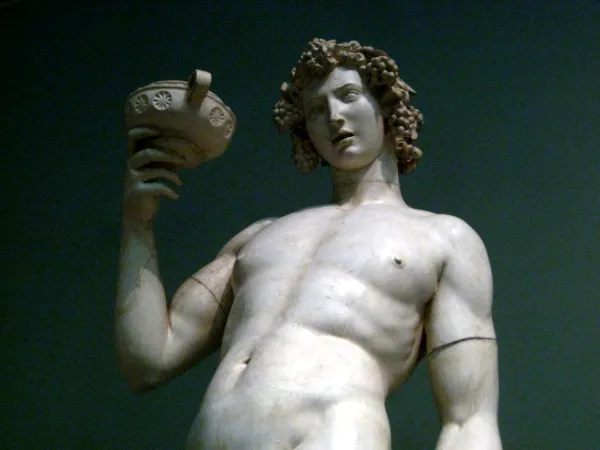
This piece of art also sparked a lot of controversies. Cardinal Raffaele Rario initially commissioned it. The inspiration behind this sculpture was a lost bronze description sculpture by Praxiteles, an ancient sculptor. However, after Michelangelo finished his handy work, Cardinal Raffaele Rario rejected it because it was inappropriate to see the final product.
At the start of the 16th century, the sculpture was sold, and found a home in the Roman palace of Jacopo Galli, Michelangelo’s banker.
Even though the piece has a twisted past, it still holds the creative ingeniousness that Michelangelo held. One of the most famous descriptions that this sculpture is from Vasari, who says that the artwork keeps a young man’s slimness but the woman’s skin texture. Michelangelo’s unique depiction of a Roman god in a socially unacceptable drunken and swaying state is a one-of-a-kind artwork that remains one of the benchmarks of creativity and originality.
Today, the sculpture resides in Museo Nazionale del Bargello in Florence. It has been stored alongside other Michelangelo works like the incomplete sculpture called David Apollo and another complete Brutus bust.
4 – La Pietà: the most moving of Michelangelo’s works
Have you ever come across an image of Mary cradling Jesus when he was taken down from the cross? I bet you have at some point while browsing the internet, maybe in a scene in a movie, a picture painted on the wall somewhere, or maybe in a book?
Now that’s what is referred to as Pieta – La Pietà, in Italian. Together with his other work, David, the Pieta is considered one of Michelangelo’s best artworks and s without a doubt among the best known since its birth towards the end of the 15th century.
These sculptures were mainly known in the North of Europe and were a rare occurrence in Italy. Michelangelo saw this as an excellent opportunity to leave a mark that will forever. And true to that, the piece of art made people know him and talk about his artworks on a broader scope.
It was primarily created to be placed at the tomb of Jean de Bilheres, a French cardinal. After he was crucified, Mary’s image holding Jesus in her arms was a common funeral theme during Italy’s renaissance period.
The Pieta is one among the seven sorrows of Mary, contained in the Catholics’ devotional prayers, and it also brings to life what had been prophesized by prophet Simeon.
It was commissioned by Jean de Bilheres. Being that the sculpture’s commission emerged from France, Michelangelo had the opportunity to do something a little different and bend more on the French artistic styles than the usual Italian. While talking to Michelangelo, Jean said that he wanted to acquire the most beautiful artwork, made of marble. An artwork that no other artist in that time and the history of humanity could sculpt better. It took him two years to sculpt this masterpiece to completion using one block of marble.
Even though other Pieta sculptures emerged as religious monuments in the 1300s in Germany, the whole depiction had significant connotations in the Italian art Renaissance. Several artists attempted to translate the religious tales in a humanistic way by blurring divinity and humanity’s boundaries by humanizing the known biblical figures and freely exercising their freedom of expression. In most cases, Mary was used.
What draws clear lines between other artists’ works and what other sculptors made is that he portrayed Mary, not as a middle-aged woman but a rare youthful beauty. He at one point talking to his biographer that chaste women stay much fresher than the unchaste, hence his preference for the young beautiful virgin Mary.
Michelangelo also moved away from portraying Mary’s suffering, which was being shown in most of the time’s sculptures; he instead brought out the intimate sense of tenderness of a mother for her child. In the statue, too, Jesus’ hands have minor marks of the nails from his recent crucifixion, and so is the wound on his side. In this depiction, Jesus looks more like a sleeping child in the hands of his mother than being dead, which could be looked at as a symbol for his resurrection.
It should be noted that this is the only sculpture that contains Michelangelo’s sign. This was a response to a circulating rumor, claiming that the incredible artwork was created by one of his rivals, Cristoforo Solari. Michelangelo carved his name across and split it in two so that it read Michael Angelus. This can also be interpreted as a reference to another biblical figure, Angel Michael. This was a selfish act that he later came to regret and swore never to sign on any other of his artworks. This is why the Pieta is the only Michelangelo’s work signed.
Following its completion, the Pieta instantly acquired its fame and was a cornerstone to his fame. An attack in 1972 caused damage on the virgin Mary’s arm and face but was later restored. The sculpture continues to strike awe in the eyes of every one of goes to visit.
Michelangelo’s work includes other sculptures closely related to the Pietra. They include Rondanini Pieta, The Deposition and the Palestrina Pieta.
5 – Moses: the angriest of Michelangelo’s works
Moses was initially commissioned by Pope Julius the second in 1505 to be a part of his funeral monuments. This came after the fame that followed Michelangelo soon after the completion of his artwork, David. Pope Julius made this commission but was, however, not completed until he died in 1513. The 235cm high sculpture was completed later in 1542.
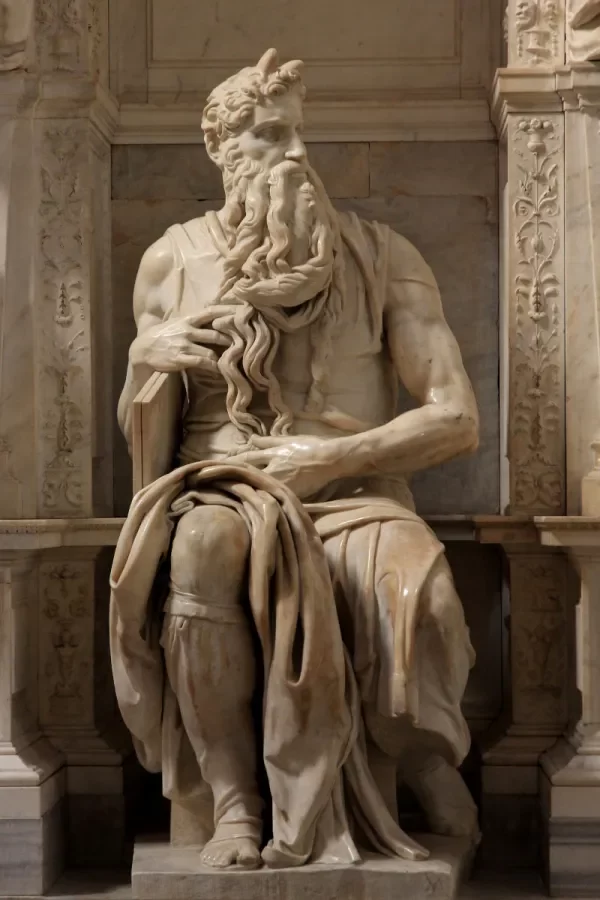
This sculpture captures a moment in the bible in the Exodus story of Moses. Do you recall the whole story of how Moses journeyed with the Israelites from the land of Egypt? I’ve got your back, listen in, let me give you a bit of history so we can be on the same page here.
In this sculpture, Michelangelo captures when Moses had witnessed his people turn against God and begin to worship a pagan god, the Golden Bull. Remember that this was when Moses had just walked down from the mountain called Sinai to receive the ten commandments and carried the stone tablets written on them. The stone tablets were heavy, and the sight of Israel’s people worshiping a pagan god had greatly angered Moses. I’m sure we are now together on this little history lesson.
It is that exact moment that Michelangelo captures in this incredible artwork. He aims to portray the anger that was on Moses’ face at that precise moment. He skillfully carves out the emotional moment in this eight-foot sculpture of Moses in a seated position. Without a doubt, this is the angriest masterpiece of Michelangelo’s works.
Michelangelo captures this moment with Moses in the seated position, facing the left, while his beard shifts to the right, indicating a moment of movement. His left leg and hip are shifted to the left, and his built trunk faces the right, bringing in a moment of immense tension and great power.
The notable prophet’s sculpture is marked with great emotion behind it, but he also brings out fine details of the cloth Moses is wearing with great perfection and a final authentic look. See, this is a real-life moment brought out with a lot of emotion and perfection, all of which is captured in stone. Incredible.
This particular artwork has attracted a lot of analytical attention to the heights of it all, including Sigmund Freud. He purposely dedicated three weeks of his time in 1913 to study this sculpture’s emotional details. He later gave his opinion on the same, noting that it was a predominant sight of self-control. He was also aware that the statue cared more secular than religious meaning, symbolizing a man who stood for the inward passion searching for a higher cause.
A controversy was born from what appears to be horns protruding from Moses’ head. Some people interpreted it as a symbol of his anguish, while to others, it was a Latin misinterpretation of the bible so that instead of having bright rays of light shining on the great prophet, they have horns growing from his head. This could have stemmed from the Hebrew word; Keren, which is interpreted as illuminated light or had grown horns.
6 – The Last Judgement: the most emotional of Michelangelo’s works
Moving back to the Sistine Chapel, we meet another masterpiece of Michelangelo’s works, The Last Judgment.
It is located on the walls of the altar in the church. This outstanding piece of art was completed 25 years after the completion of the Sistine Chapel ceiling fresco. This artwork is one of the final pieces commissioned by pope Clement the seventh when the great sculptor was 62 years old. The masterpiece depicts the second coming of Jesus when he is delivering God’s last judgment to humankind. It took five years to complete the artwork, which comprises well over 300 human figures. It is one of the most complex pieces of artwork that portrays a violent scene body movement. Of the approximately 300 masculine human figures in the painting, some are mortals ascending to heaven. In contrast, others on their way down to hell, and others were immortal beings engaged in violent actions.
The intensity in this rare piece sparks out a lot of emotions in the viewers. Awe and fear are the dominant emotions brought out in the scene. At the core of the whole fresco is the image of Christ, with his hands exposing the wounds he suffered from being crucified. He gazes down on the humans as each takes on their judgments.
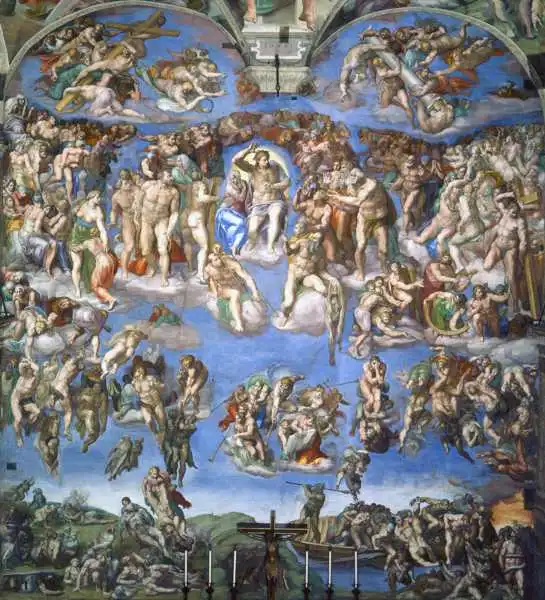
On the right-hand side of Jesus is the virgin Mary looking upon the saved souls ascending to heaven. On the opposite sides of Jesus stands John the Baptist and Peter with the keys to heaven’s gates in their hands. Most of the mage saints are identifiable by the distinguished marks they got as a sacrifice during their time on earth serving Christ. An excellent example of this is Bartholomew and whose face is said to be the portrait of Michelangelo. It also reveals seven angels who are blowing trumpets and can be interpreted in Revelations’ book, where it talks about the world’s end.
The artwork received a lot of controversy for the massive amount of nudity that it portrays. In 1654, the fresco was condemned by the Council of Trent and ordered the nude parts to be painted Daniele da Volterra. His depiction of Jesus being beardless was also unwelcome, as t was mainly identified with figures from Greek mythology.
7 – The Dying Slave: the less-known masterpiece
The dying slave was primarily meant to accompany another sculpture of a rebellious slave and, together with Moses, be a part of the sculptures at Pope Julius the second’s tomb. Michelangelo set out to the quarries of Carrara to handpick the perfect marble and begin working on the statue. On his return, however, pope Julius canceled his commission.
This is one of the less-known masterpieces of Michelangelo’s works. The dying slave only counts as one among the six sculptures of slaves that Michelangelo created over many years for the Pope. These were all to make the perfect resting place for the Pope when he begins his journey to the afterlife. However, the project was never fully realized, which utterly disappointed Michelangelo, considering that he spent the whole year in a quarry to accomplish this project. What a waste!
It would have been one of Michelangelo’s showcases of perfection in the craftsmanship and the portrayal of his understanding of the human anatomy. Are you thinking what I’m thinking? The sculpture of the slave portrays a human figure frustrated by the circumstances in his surrounding, right? It could have been anything at the time. Come to think of it, this sculpture of the seemingly frustrated slave could as well be portraying Michelangelo’s situation when dealing with these projects for Pope Julius the second and his struggles to find the authentic materials to use.
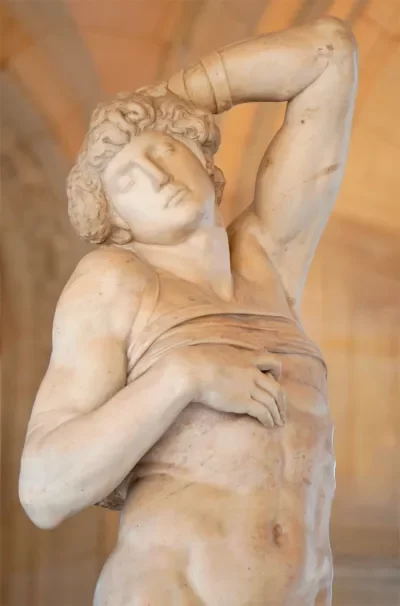
Conclusion - Why Michelangelo Buonarroti is so important
Michelangelo Buonarroti stands as one of the most extraordinary figures in the history of art, whose works have made an indelible mark on the world.
His contributions to the domains of painting, sculpture, and architecture are immeasurable and his mastery of the human form remains unsurpassed. Here are several reasons why Michelangelo's legacy is so crucial:
Mastery across multiple disciplines
Michelangelo was not just a painter; he was also a sculptor, architect, and poet. His versatility across these disciplines illustrates the depth of his genius. Few artists have achieved such mastery in multiple areas of the arts.
The High Renaissance
Michelangelo was a pivotal figure in the High Renaissance, a period that marked the pinnacle of the Renaissance and its ideals of harmony, balance, and realism. With his peers Leonardo da Vinci and Raphael, Michelangelo is credited with elevating and greatly influencing Renaissance art and culture.
Innovative Techniques and Artistic Influence
Michelangelo’s works in painting, sculpting, and even planning architectural works was often pioneering. He forged new pathways in art, from his use of fresco in vast ceiling paintings to his "non-finito" (unfinished) sculptures that give a powerful sense of an incomplete form emerging from the stone.
His influence can be seen in countless artists who followed, establishing a canon of techniques and styles that persist today.
Humanism embodied
Reflecting the humanist beliefs of the time, Michelangelo's works spotlighted the beauty and potential of the human being, both physically and spiritually. His works often express humanistic ideas about man’s relationship to God, his place in the universe, and the nature of beauty.
A symbol for the artist as a creative genius
Michelangelo represents the epitome of the "Renaissance man", a person of unquenchable curiosity with knowledge in wide-ranging fields, but particularly an individual of overwhelming creative power. His life and works helped to establish the notion of the artist not just as a craftsman but as a creative genius who could rival even nature in his creations.
Cultural and historical significance
Beyond the arts, Michelangelo has had a profound cultural impact. His works and persona have been celebrated in literature, film, music, and more, making him an integral part of the tapestry of Western civilization. His name and his creations are woven into the fabric of world heritage, representative of human achievement.
In summary, Michelangelo Buonarroti's importance lies in his immense contribution to the art world, his embodiment of the Renaissance humanist spirit, his role in shaping Western artistic traditions, and his lasting influence on culture and society. He remains a titan in the history of art, standing as a symbol of creativity and human potential.
Controversial as his life might have been, and even most of his artworks, Michelangelo had a uniquely distinctive way of bringing out his creativity. His vast knowledge of the human anatomy blending with his supreme artistic creativity in sculpturing left a permanent mark in the creative world. I’m not sure which one is your personal favorite of all his works, but these seven, to me, are on top of the list whenever we talk about Michelangelo’s works.
If you want to add your personal piece of Italian Renaissance to your home, look for breathtaking Fine Art Photographs at Paolo Modena Photography
Editor's note: this post was originally published in March 2023 and has been completely revamped and updated for accuracy and comprehensiveness.

